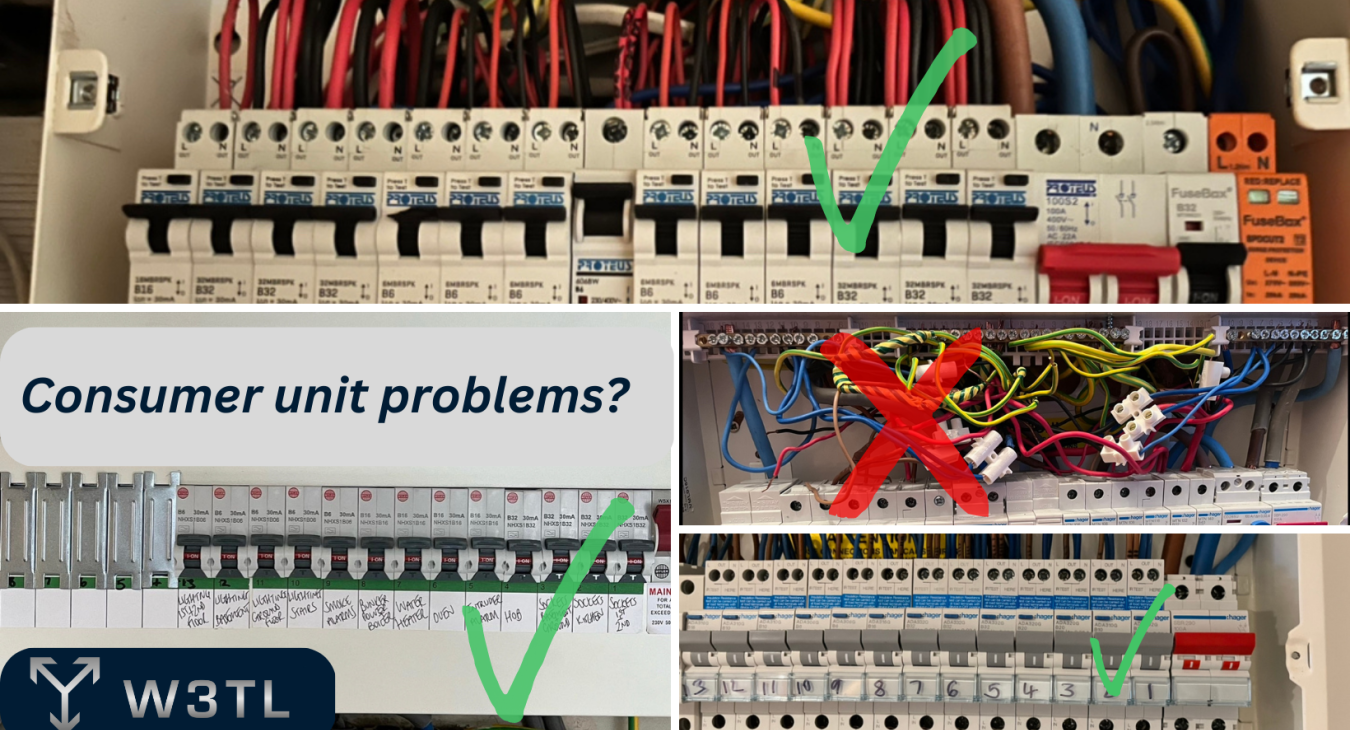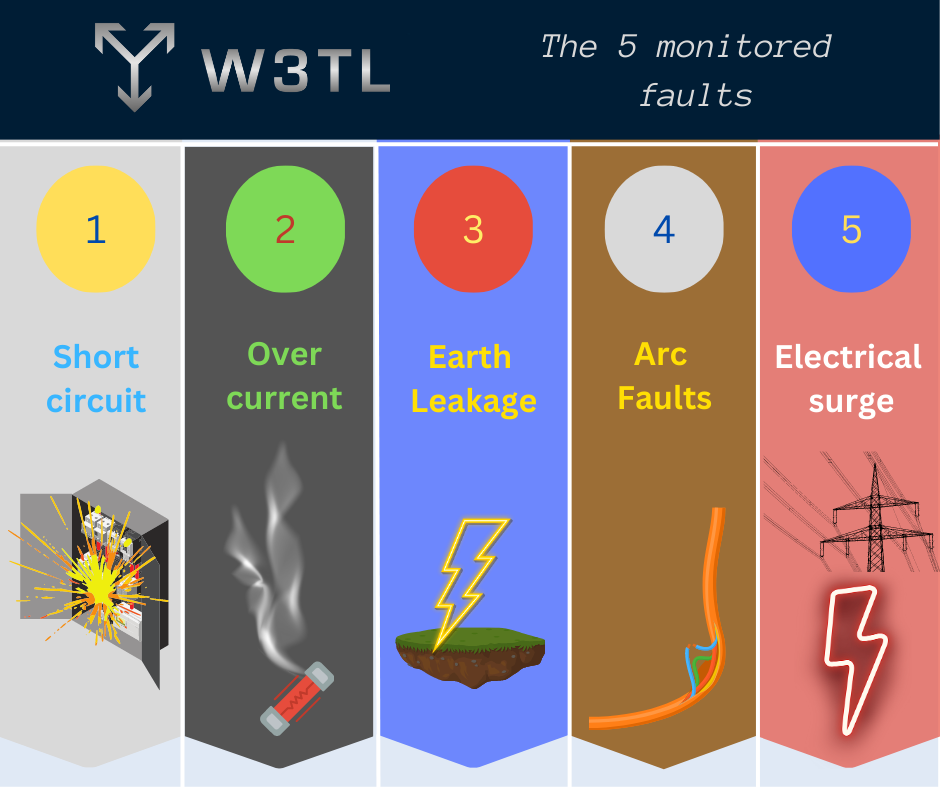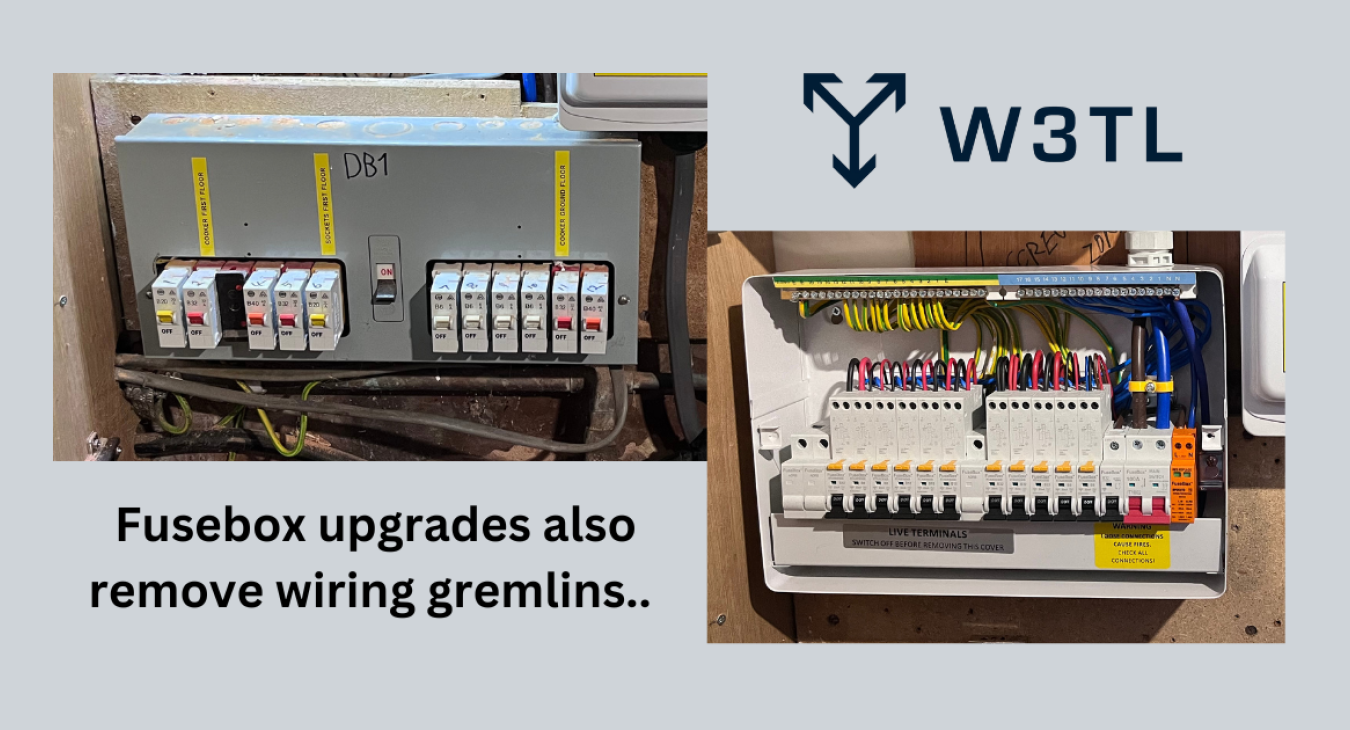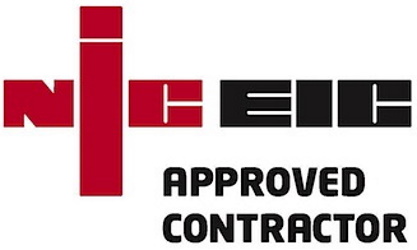
The Four Most Common Problems With Consumer Unit In a Home
If you are in the market for consumer unit work and you have done some research online, then it’s likely you will have read about some of the problems that having this work carried out could potentially generate.
Modern day consumer units represent a significant cost to a homes wiring. We are installing more circuits than we have in the past and are protecting them with devices that cost 100 times more than fuse wire.
With these new devices, we are able to detect more, and protecct more. This does mean those faults that have gone unnoticed for some time may now be causing problems with a new consumer unit
The aim of this article is to fully disclose the top four most common problems associated when having this type of work carried out. But we’ll go a little further and discuss the causes of these problems and how, as a consumer, you can best avoid them. In the spirit of being honest and completely transparent, I will point out that these problems are quite uncommon and are very avoidable.
The top 4 consumer unit problems and solutions
1. Consumer unit isn’t labelled or isn’t clear as to what the various circuits do
2. Consumer unit trips out frequently
3. Consumer unit has been condemned and it’s not clear why
4. The switches are all on, but you still don’t have power
Top 4 consumer unit problems and solutions
Problem #1: Consumer unit isn’t labelled or isn’t clear as to what the various circuits do
A modern home will typically have around 10 circuits. If there is a fault, less of the electrical system within the building is affected: Lots of smaller circuits is better than fewer big circuits.
The problem put simply is this: We cant test a circuit if we don't know what it is. This is a maintenance thing, but it is one of the biggest contributors to increased down time, inspection time, and repair costs when it comes to fault finding and upgrades.
What’s the solution?
Well, we can’t change the fact that many electrical systems are in some cases forty years old or more. In this time frame it’s easy to lose the bit of paper with the circuits on, or the paperwork that was given to the owner when the consumer unit was changed/installed. Not to mention that stickers can fall off and marker pen can become faint.
But to ensure that you are getting a consumer unit that has been labelled up and marked clearly, its best to sort this problem out before any major upgrade works to the electrical system.
Doing this can be a little more difficult that is sounds. Easy answer: switch it off and see what goes off. This can work, however, if you switch something off, let’s say a socket, and you don’t know that it feeds a socket, how long would it take you to notice that it’s that socket that’s gone off? Some sockets are behind a wardrobe…
This can be rather time consuming.
Unless you, or the installer replacing your consumer unit has factored time in for ensuring that all circuits are identified before the work is carried out, its likely that it will not be done until after the unit has been replaced. The installer can either connect it up and leave it off, connect it up and leave it on, or they can refuse to connect it up and assume it does nothing. None of which are particularly helpful.
Well-trained electricians
There is no guarantee that an electrical circuit which is connected at the consumer unit will be found. This could be because it has been disconnected somewhere and so it feeds nothing, and in this instance, we shouldn’t reconnect it. However, a well-trained electrician can improve the chances of finding a circuit that is not labelled with the use of specialised tracing equipment.
We shouldn’t be connecting a circuit that does not appear to do anything. This is because if we can’t see what it does and where it goes, then we can’t confirm that it is fit for purpose and safe for continued use.
PROBLEM: poorly or unlabelled consumer unit
SOLUTION: Cable tracing and identification process prior to starting any consumer unit upgrade works.
Problem #2: Consumer unit trips out frequently
We’re installing more electrical equipment and technology into our homes than ever before. For many, working from home has become common, and if you run into electrical problems, it can have a big impact on your everyday life.
The problem is this: If you have a consumer unit tripping out, it will withhold power until you can clear the fault. Sometimes, this can mean waiting for an electrician to come out and repair the problem for you. Much of this downtime can be very detrimental if you rely on electrical equipment to work from home.
Depending on the type of consumer unit and the fault you are experiencing, it could be impossible to get your consumer unit to stop tripping out without carrying out testing that requires specialist tools and equipment.
What’s the solution?
Well, your consumer unit is where the wiring in your home comes back to, so we can’t say that the problem is limited to the consumer unit, as the fact of the matter is, that the fault could be anywhere, on any circuit, somewhere in the home.
Whilst it may sometimes be something that you have plugged in that is causing the problem, we also see a large number of problems relating to issues with the fixed wiring and not a faulty appliance. This is because the wiring in the home and the protective devices in the consumer unit are intrinsically connected.
To ensure that the faults that can plague our electrical supply are reduced as far as possible, we need to make sure that our homes wiring is in good condition regardless of its age. An electrical system is a complex array of different types of wires, connections and equipment, all of which are subject to failure and can contribute to an electrical fault.
Finding a fault before it’s a problem
Finding faults before they are a problem is the major benefit to an EICR (Electrical installation condition report). If you have spent any time online looking for electrical testing or consumer unit changes then you have probably run into this complex electrical topic.
EICR’s are so complex because they often reflect the personality of those that carry them out. They require a lot of time and scrutiny, and thanks to the government, are now a legal requirement in privately rented homes.
They are not a requirement at any other time, but they have been recommended at many times for many reasons and yet so few people are still having them done. If a homes wiring has faults on it, and you are only monitoring for two out of the five faults we monitor for, and you introduce a new device to your homes wiring, then you may be setting yourself up for failure. Or at least, your electrical system if it has a fault that isn’t currently being monitored for.

This is because many older electrical installations may not have any RCD protection (our third fault) as it may not have been needed when the wiring was installed. That’s ok, but now we must install it. Hence why people have their consumer unit upgraded. So, if we are going to install an RCD to a circuit that has not had any before, then it makes sense that we test that circuit before we apply such monitoring devices to it.
A very common practise is to do what the customer has asked first: change the consumer unit. Then, inline with the wiring standards and building control, we produce a certificate and notification. The problem with this method, is that if there are problems on the wiring, then these will come to light during the testing at the end of the job, and often at the end of your typical spend of around £300-£600 for a consumer unit upgrade.
Its not that the installer has introduced a fault. Its that the fault was always there, and now because you have introduced a new monitoring device, the new device is saying no to the electrical supply until its safe.
PROBLEM: Electric box keeps tripping out
SOLUTION: Check the installations wiring for faults that may not have been highlighted before the consumer unit was changed
Problem #3: Consumer unit has been condemned and it’s not clear why…
Anyone can work on their electrical system. They can change a light switch, or they can wire up their own home. We shan’t go into the problems you get with this, but they are numerous, and our industries rules and regulations don’t seem to show any signs of stopping such practices.
We have seen retired engineers produce a masterpiece of wiring having never been qualified as an electrician in their life. We have also seen electricians produce appalling and unsafe work despite having qualifications but very little hands-on experience with this type of work.
Therefore, we need to understand that any consumer unit can be condemned for any number of reasons at any time because there is often no hard proof or evidence that the units we come across have been done by anyone in particular. Put differently, whilst we can make claims and produce documents, the reality is that these systems that monitor and produce these forms and back up these statements are often highly subjective.
What’s the solution?
With there being so many attempts at installing a consumer unit by so many people both in the industry and out of it, it would be impossible to list all the ways a consumer unit could fail.
That said, there are some core things that need to be followed, and in doing so, you will likely find that your consumer unit will be just fine.
Here are the five top things that are often the cause of a consumer unit being condemned.
1. It needs to be fixed securely
It can be difficult to get a fixing into a wall. More so if there are hard bricks and soft mortar behind. This is because the bricks can crack and fracture, then the mortar falls out.
A solution here would be to mount a suitable back board on which to install all of your consumer unit and associated equipment.
2. The second layer of insulation needs to be inside the unit
Generally, a cable will have 2 layers of insulation which is typically grey or white. Therefore, if you see any other colour, then it’s likely it’s missing its second layer, and that’s when it’s a problem.
The solution is to ensure that the cables go into the unit all the way and that the second layer of insulation is only removed INSIDE the consumer unit. Having only one layer of insulation on a cable carrying electricity is always risky as the soft plastic is so easy to damage.
We also need to ensure that we are using protecting strips where we have brought these cables in. With the cabling being soft, it can be damaged, so we need to use rubber grommets and anti-chaffing measures to ensure we don’t cause premature failure.
3. The consumer unit can’t have any holes in it.
You can’t have any holes on your consumer unit unless they have a gland fitted or you have cables coming through that have then been sealed.
The solution is to cover them over with a barrier of some sort. If you can put a finger in there or even a piece a conductive material like a spoon, knife, prong of an umbrella spike for example, you could touch a live part and introduce a very risky situation resulting in a shock.
4. The wires need to be tidy and organised inside
Whilst your electrical supply may be on and working that is never enough to assume that the safety features that the consumer unit offers will actually work. For this, we need to test the unit and the wires that are connected to it.
The solution is to ensure that your wires are routed cleanly and efficiently. This will allow wires to be taken out of their terminals and connected to a test instrument whereby readings can be taken, and their operation and suitability checked. The obvious problem with a messy consumer unit (and you will know one if you see one) is that these tests can often be impossible to carryout, and as such, no information can be given as to whether the safety devices will work or not.
We all use a seatbelt (don’t we…) but its only when we brake suddenly or are involved in a collision that they actually do what they are intended to do. We can test them to ensure they lock up. Testing your homes wiring takes longer but the principle is exactly the same. We need to KNOW THEY WORK, and in order for them to do so, we need to have access to the wiring that connects to them.
5. The correct equipment will need to be used
There are more manufactures than I care to detail. Whilst they all produce the same thing, few of them are compatible with each other.
The solution is to ensure you are using the correct manufactures parts in the respective manufacturers consumer unit. Of course, this is subject to many things: mostly its availability, but often it can be price. Some parts can cost a few quid, others can cost nearly £100. This is when workarounds are made in the moment, and then left in place until that person comes in and condemns your unit.
The associated mechanical problems with this are worse. The switchgear may not line up with the units bus bar meaning the installer may need to cut out some of the consumer units cover to accommodate the mismatch part which will permanently damage the unit and introduce more long-term problems. This can also lead to fires and equipment failures
Those were the FIVE top things that account for condemned consumer units. Whilst there are other problems, these five are the most common and the most costly and time consuming if they are done poorly. Get these five things right, and the rest is pretty simple.
Problem #4 The switch is on but the power is still off
With the large number of manufactures available producing all the same things at varying degrees of competency, it’s inevitable that you are going to get some differences in performance.
Many of the problems associated with loss of power in an otherwise healthy electrical system has to do with the switchgear that is supplying it.
The problem simply put, is that if your wiring is healthy, then there is no reason why, when you turn the switches back on, that the power shouldn’t be restored.
What’s the solution?
Well, we will assume you have paid the electricity bill.
Beyond flipping switches, which, as a consumer, you’d be able to do, fault finding on the consumer unit will need a screwdriver and some knowhow.
There are numerous points of contact inside a consumer unit: going from where the power comes in from your meter to the point where the power leaves the unit to supply power to any of the circuits that are connected to it. Therefore, we need to test all these points until we find the fault.
If the power is on, and you don’t have any power to the circuit, it could be that it’s a simple loose connection. Or it could be that the equipment you have installed: MCB/RCBO/RCD has outright failed and is no longer working. This can happen, although it is rare. I have seen switches out of the box fail and not work correctly.
Strange, given that these devices are tested in the factory and given a QC sticker only to then fail the test when they are being installed. There are some manufactures that this occurs with more often that others. Some manufacturers use methods and materials that are superior and because of this their switchgear costs more. Not that it does the job any better, but it does it more reliably and for longer.
I hope this article has been helpful to you. At w3tl we strive to produce installations and repairs that are robust and hardwearing so that you, as a consumer, can have peace of mind that your electrical system is operating safely and reliably. We limit downtime of your electrical because we factor these problems in and engineer solutions around them to reduce the number of cases we see when we conduct inspections and tests on existing systems. Correct mapping of an electrical system is quickly becoming a luxury that many homeowners will not benefit from because of ability, time and material cost to supply such mapping, and it being a task that does not affect the installations day to day running until there is a problem.
These problems are avoidable, but they are also, in the electrical industry, covered by rules and legislation that details them as a should, and not a must, making these practices difficult to enforce and police.
















